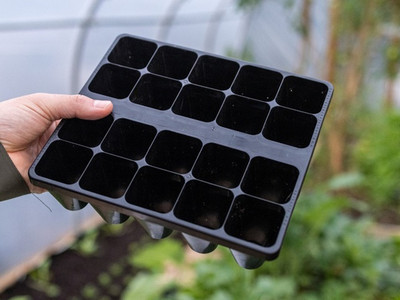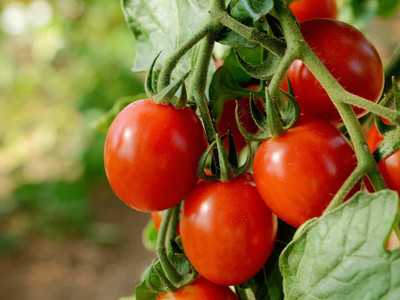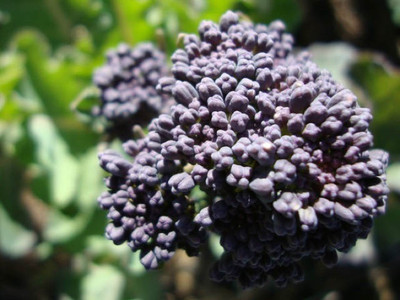The Vegetable Garden in March

March can be a deceptive month. The season is clearly starting to turn with warmer days, grass beginning to grow and buds opening on fruit bushes, yet it is still too early to sow most outdoor crops. It is a month that requires significant action however: sowing of warm climate crops indoors, planting potatoes and onions sets and getting seedlings started on a windowsill or propagator for planting outside in 4-6 weeks.
Everyone's garden will be different depending on your location, but I include my list of March jobs below. As you probably know by now, my garden is in the North West but if you have a balmy southerly location you may be able to start a couple of weeks earlier than me. I have included March dates from my calendar before each crop if it is helpful.

Chilli and Sweet pepper - Sow by mid March at the latest
I sowed my chilies and sweet peppers last week, but there is still time to sow provided you get them in before mid-March. Both need a long growing season and plenty of heat and light to grow. For most gardeners they are an indoor crop so need to be started on a windowsill or in a greenhouse or polytunnel.
Bear in mind that chilli peppers are easier to grow than sweet peppers, primarily because of the size of their fruit. Large sweet peppers take a long time to ripen; if the summer doesn't go your way you may run out of season before they are ready to pick. Chillies ripen quicker, are much more prolific and will give you a better return for your effort.

Tapered peppers
If you have your heart set on growing sweet peppers it may be better to grow tapered varieties like 'Corno di Torro Rosso' (pictured above) or 'Marconi F1', as they are quicker to ripen.
Many of the tapered sweet pepper varieties have been bred in Europe and are better adapted to lower temperatures and light levels than their south American cousins. They have thinner skins so don't expect the big juicy crunch of a bell pepper, but they are still deliciously sweet and versatile to cook with.

Both chillis and sweet peppers need a temperature of at least 22˚C (I find 25˚ best) to germinate reliably, so will need a warm and sunny windowsill or a propagator to get started. It is best to sow in a seed tray before pricking out and potting on to individual pots (pictured above) 3-4 weeks after sowing.
Pepper seeds take 2 weeks to germinate so I prefer to use vermiculite to cover the seeds as there is less chance of seeds rotting or seedlings suffering from damping off disease.

Tomatoes - Sow by mid March at the latest
Tomatoes are sown at the same time as chilies and need more or less the same conditions to grow. When choosing a tomato variety bear in mind that, like chillies, the larger fruits take longer to ripen. Northern gardeners may struggle with large beefsteak varieties, so may be better off with cherry or medium-sized tomatoes which will crop in a shorter season.

Tomatoes are also best sown in seed trays and potted on to individual pots. There is a significant advantage with tomatoes, as their stems will grow roots if buried: so if your seedlings have gone a bit leggy they can be saved by deep planting.
I pot on twice before planting out, each time burying the stem up to the first set of leaves, which helps to build an extensive root system. For more details on sowing tomatoes, see this article.

Outdoor Cherry Tomato 'Primabella'
View Product
Winter Leeks - Sow Mid March
I mentioned in my February garden update that there are three main sowing dates for leeks: February, March and May, using varieties that will either mature in the autumn, over winter or the following spring. There are also three sowing methods, including sowing in modules, seed trays or in a seed bed outside for later transplanting.
The reason leeks are transplanted is to get a more white or 'blanched' shaft. The seedlings are planted out in deep 12cm holes up to their first leaf joint. This buries a portion of the shaft in the soil, excludes light and therefore blanches the lower part of the leek. To increase the amount of white stem, leeks can also be earthed up in the same way you would potatoes, once or twice in the season.

I don't bother sowing outdoors but I do sow my early (autumn harvested) leeks in modular trays (3-4 per cell) and plant them out as is. I don't deep plant them but plant them in clumps which gives me tall, slender and sweet green stemmed leeks.
For my March sowings I use polystyrene fish boxes and broadcast sow ('broadcast' means loosely sow over the entire surface rather than sow in rows) leeks around 6cm apart for planting out 8-10 weeks after sowing. The reason for the polystyrene boxes is they provide insulation and can hold enough compost to sustain the leeks until they are planted out.

The boxes need to be around 15cm deep and have holes punched in the bottom for drainage. They usually come with a polystyrene lid which is handy for keeping the heat in but needs to removed as soon as the leeks come up.
I keep the leeks in the polytunnel until mid May when they are transplanted in the garden in 12cm deep holes made with a dibber. BTW, the photo above isn't mine but is a still from the excellent Allotment Diary YouTube channel where the above process is very well explained.

Celeriac and Celery - Sow Mid to Late March
Celeriac and celery are both umbellifers so are also related to... anyone? anyone?... carrots. I sow both in mid March but whereas celeriac is sown only once in the season, celery can be sown in March, April and May for staggered harvests from summer until late autumn.
Celery and celeriac are also broadcast sown in a seed tray and pricked out and potted on to modular trays 4-5 weeks after germination. Although it might seem counter intuitive, the seeds should not be covered with compost after sowing as they need light to germinate.

Celeriac 'Prinz'
View ProductThe surface of the compost needs to stay moist while the seeds germinate (which can be up to 3 weeks!) so it's handy to place a piece of glass over the seed tray to reduce evaporation. If I need to water I use a bottle top waterer or a mister.
Onion sets - Plant mid March to mid April
Onions can be either grown by sowing seed or planting sets. I have sown seeds in trays at the end of February but will also be planting sets in late March. Sets are immature onions lifted last season when they were marble sized, when replanted they will resume growing and will be ready for harvest in October.
I made a video a few years ago showing how to plant sets which you can watch above, evolution has remained at it's usual pace since I filmed it so thankfully the content is still relevant.

Cucumbers and Courgettes - sow late March to mid April
Cucumbers are very fast-growing plants but they are also tender (especially cucumber) and will be prone to frost damage or stem rot from cold, wet soil. They are often sown in early March with peppers and tomatoes, but you are better waiting until late March for courgettes and mid-April for cucumbers. These 'late' sowings will easily catch up with earlier sown plants and will likely overtake them.

Courgette 'Defender F1'
View ProductI sow both in individual 7cm pots at a heat of between 20 and 22˚C, before potting them on to 12cm pots 3 weeks after sowing. They are planted in the polytunnel in May for courgettes and early June for cucumber. As I said, they are susceptible to rot so make sure not to overwater the pots.

First Early Potatoes - Mid to late March
First early potatoes are planted in mid to late March, preferably mid March if the weather allows and the soil is workable. The photo above is of potatoes that have been sprouting or 'chitting' since early February. You can see they have stubby shoots because they have been in a cool, bright place; this is how you want them because the stubby shoots won't break off when they are planted out.
If you haven't sprouted your potatoes they can still be planted, all that chitting does is bring forward the harvest date by a couple of weeks.

Broad bean - Sow late february to late April
You might remember that I sowed broad beans in modules in mid February; they are growing fast now and will be planted out in the middle of the month. At the same time I will sow directly into the ground, which will give me a second harvest four weeks after the module sown batch.

Bean, Broad 'Aquadulce Claudia'
View ProductThere are two main types of broad bean, Longpods and Windsors. The longpods tend to be hardier and include overwintering varieties like Aquasdulce Claudia or late winter varieties like Witkeim Manita (which is what I have in modules). Windsor broad beans (e.g. 'The Sutton') are less hardy but are said to have better flavour; I prefer to sow the Windsors in March.

Brussels sprouts, calabrese and cauliflower - sow end of March
All three of these cabbage family members can be sown at the end of March, with further sowings until May for Brussels sprouts and June for calabrese and cauliflower.
I sow in modular trays and plant out 4 weeks later at the end of April. As with nearly all outdoor crops, a germination temperature of 18˚C will have them up in under a week. Once they have germinated, even if only half of them have come up, take them off the heat or they will get leggy.

Charles Dowding 60 Cell Plant Tray
View ProductChances are that if half of the tray has come up, the other half has germinated but you just can't see them above ground yet. They will probably appear in a day or two even when taken off the heat. I cover any trays taken out of the propagator with fleece for the first few days, in case night time temperatures are very cold.

Lettuce Pray
Lettuce can be sown outside from early April, but if you start seeds indoors in March you can have lettuce plants ready to plant out at the same time. Like celery and celeriac, lettuce seeds should not be covered by compost as they germinate better with light. I make a little indent with my finger in the compost, which holds the seed nicely and helps prevent it getting washed out if you need to water.
It is better to wet your compost before filling your seedling trays as it avoids overwatering later on. I would say this is advisable whatever you are sowing, but especially so in the case of lettuce where the seeds are easily disturbed. Covering with a sheet of glass will keep moisture in. If you do need to water use a very fine spray.

The Polytunnel
I was going to feature the polytunnel in detail but I am afraid I am out of time, I will come back to it next week as there is plenty going on.
In brief, you can sow the following direct in beds: forcing carrots, beetroot, french beans, mangetout peas, radish, turnip.
You can sow the following in modules for planting in the tunnel later- Aubergine, basil, lettuce, spring onions, coriander, early cabbage, calabrese, mini cauliflowers, celery, chilli, courgette, French beans, Kohl rabi, spring onions, perpetual spinach, oriental salads.




